|
Report from
Europe
Slow recovery in European furniture production
After a two-year period when the value of furniture
production in the EU27 fell by over 10%, in 2024 sinking
to a level lower even than in 2020 at the height of the
pandemic, production was showing some signs of
recovery in the opening months of this year.
Eurostat data indicates that seasonally adjusted furniture
production in the EU27 during the first four months of
2025 was up by around 1.5% compared to the previous
year.
Furniture production was rising in several EU countries in
the first four months of this year, notably Lithuania,
Poland, Spain, and Italy. Production in all four of these
countries, which has been outpacing that in nearly all other
EU countries in recent years, is now above the pre-
pandemic level.
Production also recovered ground in Portugal, Romania,
and Denmark in the opening months of 2025, although in
each of these countries production is still well down on the
pre-pandemic level. Production in Germany, Sweden,
France, Belgium, and the Netherlands continued to
stagnate in the first four months of this year (Chart 1a).
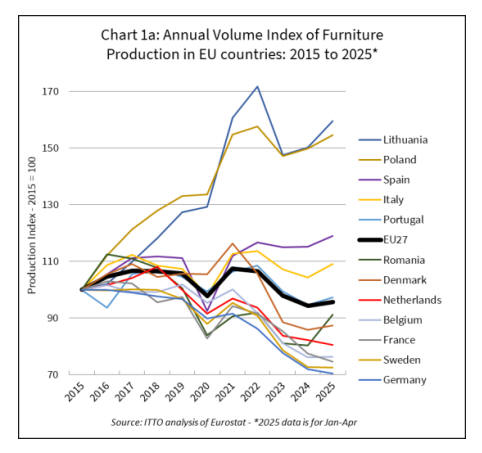
In the latest issue of their in-house journal, World
Furniture Online (www.worldfurnitureonline.com), the
Italy-based market research organisation CSIL reports that
total furniture consumption in Europe fell by 3% to €106
billion in 2024. This followed an 8% decline the previous
year (Chart 1b).

On market prospects, CSIL observes that in Europe
“furniture demand is forecasted to remain almost stagnant
in 2025 and slightly improve in the medium term. Some
positive factors that could support a recovery include a
slight improvement in macroeconomic indicators, an
expected easing of inflation and interest rates, and
potential wage growth. These factors could boost
consumer confidence and encourage spending on
furniture”.
CSIL acknowledges that their forecast of European
furniture market prospects is “subject to a higher-than-
usual degree of uncertainty” and that the “overall
economic and geopolitical environment remains volatile,
with potential downside risks”. But CSIL also highlight
the underlying resilience of the European furniture sector,
despite recent global market volatility, underpinned “by
major retail chains and manufacturers operating on a
European scale” which benefit “from strong internal
cohesion and a well-established trade network”.
CSIL note that “this structural strength not only underpins
its stability but also drives the substantial concentration of
export and import flows within the region”.
The resilience of this sector was evident at the Interzum
show for suppliers to the furniture industry in Cologne
during May. A total of 1,616 exhibiting companies from
57 countries on a gross exhibition space of 176,000 square
metres and around 60,000 trade visitors from 157
countries took part in the show. Despite the sluggish
market, these figures were only marginally down on the
previous show in 2023.
European furniture exports remain flat while imports
rise rapidly
The latest Eurostat and UK trade data (Chart 2) shows that
European exports of wood furniture to countries outside
the region, after rising and then falling rapidly between
2021 and 2022, have remained stable since then at
annualised level of just below 1.5 million tonnes.
In contrast, European imports of wood furniture from
other parts of the world began to increase in the second
half of 2023, a trend maintained throughout 2024 and in
the opening months of 2025. Imports from outside the
region in the 12 months ending March 2025, at 2.9 million
tonnes, were close to those at the height of the boom in
2021 and 2022.
Internal European trade in wood furniture, which was
slowing in 2023 and the opening months of 2024, has also
been rising since the middle of last year.
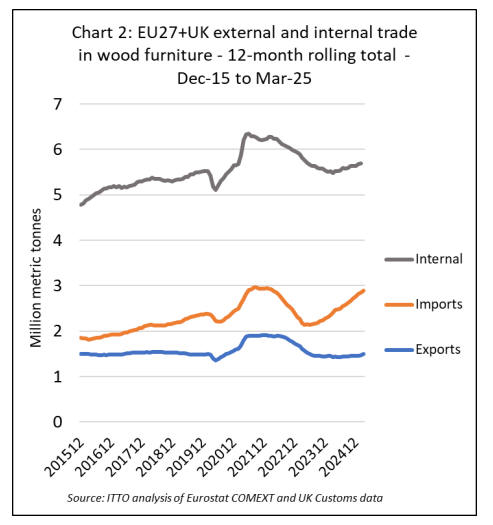
China drives rise in European furniture imports
Close analysis of Eurostat data reveals that the recent
growth in wood furniture imports into the EU27+UK has
been driven almost entirely by China. Imports into Europe
from China, after rising 5% in 2023, increased by more
35% to 1.68 million tonnes in 2024 and were up 27% to
470,000 tonnes in the first quarter of this year (Chart 3).
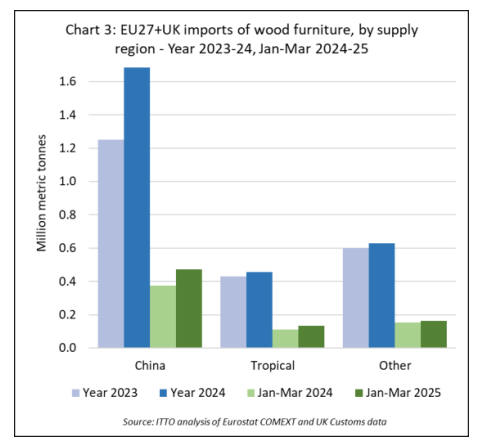
EU27+UK wood furniture imports from tropical countries,
after falling by 23% in 2023, were up 6% to 454,000
tonnes in 2024. Imports from all other countries (mainly
non-EU European countries and Turkey), after decreasing
8% to 590,000 tonnes in 2023, rebounded by 5% to
630,000 tonnes in 2024 and by another 6% to 160,000
tonnes in the first three months of 2025.
Wood furniture imports from China have increased both
into the UK, the largest single wood furniture importing
country in Europe, and into the EU. UK imports from
China increased 13% to 417,000 tonnes in 2023 and were
up another 17% to 488,000 tonnes in 2024. In the first
quarter of this year, they were 147,000 tonnes, up 26%
compared to the same period in 2024.
EU imports of wood furniture from China were up only
3% in 2023 to 833,000 tonnes but increased 44% to
1,196,000 tonnes in 2024. In the first quarter of this year,
EU imports of wood furniture from China were 147,000
tonnes, 27% more than the same period in 2024. Imports
of wood furniture from China have been rising rapidly into
all EU countries, but the gains have been particularly
dramatic in the Netherlands and Spain where they
increased by more than 50% in 2024 and have gained a
further 50% in the first quarter of this year.
The rise in Chinese wood furniture imports into European
countries in 2023 and 2024 is partly explained by the fact
that it followed a big decline in 2022 when Chinese
exports were seriously impacted by rigorous lockdowns
during the pandemic. And while high production costs are
impeding the international competitiveness of European
furniture products the competitiveness of Chinese products
is benefiting from continual improvements in technical
performance, manufacturing efficiency and from
increasing investment in advertising and marketing.
On-going trade tensions between China and the US, which
remains the largest export market for Chinese wood
furniture products, is now providing a strong incentive for
Chinese manufacturers to diversify their export sales in
other parts of the world, with Europe being a natural
target.
The accelerating pace of imports from China during 2024
and the first quarter of 2025, at a time when underlying
growth in European consumption is stagnant, may also be
related to EUDR. European importers may be building
stock in advance of that law being enforced, originally
scheduled for 30 December 2024 but delayed until 30
December 2025. The full impact of EUDR on EU imports
of composite products like furniture remains to be seen but
is likely to be very significant given the challenges of
meeting the far-reaching traceability requirements.
European imports of tropical wooden furniture recover
lost ground
Following a steep decline in 2023, European imports of
wood furniture from the three largest tropical supplying
countries – Viet Nam, Malaysia, and India - recovered
some lost ground in 2024, a trend which continued in the
first quarter of 2025 (Chart 4).
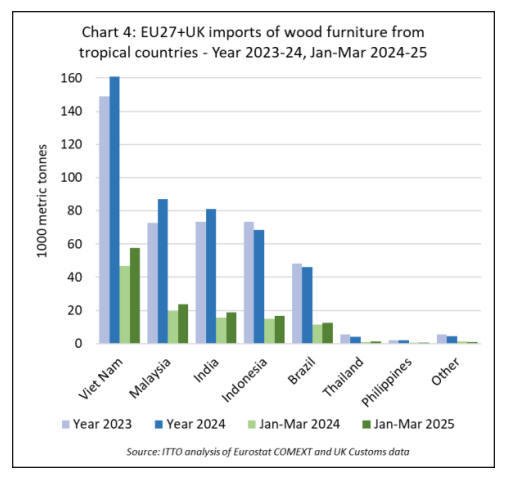
EU27+UK imports of wood furniture from Viet Nam
increased 8% to 161,000 tonnes in 2024 and were up 23%
to 58,000 tonnes in the first quarter of this year. Imports
from Malaysia increased 20% to 87,000 tonnes in 2024
and were up 22% to 24,000 tonnes in the first quarter of
this year. Imports from India increased 10% to 81,000
tonnes in 2024 and were up 19% to 19,000 tonnes in the
first quarter of this year.
EU27+UK imports of wood furniture from both Indonesia
and Brazil declined last year, respectively by 7% to 68,000
tonnes and by 5% to 46,000 tonnes. However, imports
from both countries started this year more strongly.
Imports of 17,000 tonnes from Indonesia in the first
quarter of 2025 were 11% more than the same period last
year. Imports from Brazil of 13,000 tonnes were 13%
more than the same period last year.
After most European destinations for tropical wood
furniture recorded a large downturn in 2023, there was
slow recovery in all the main markets in 2024, a trend
which continued in the first quarter of 2025 (Chart 5).
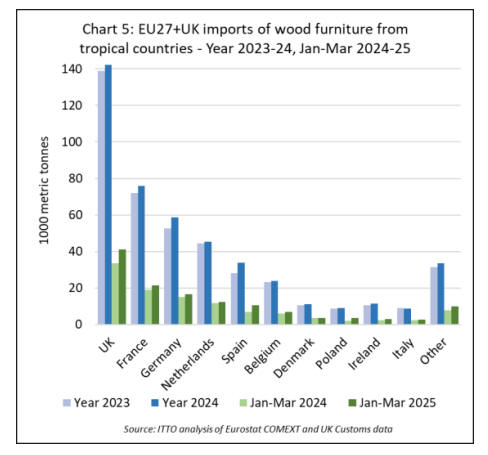
During the first three months of this year, imports of
tropical wood furniture increased in the UK (+23% to
41,200 tonnes), France (+13% to 21,300 tonnes), Germany
(+11% to 16,800 tonnes), Netherlands (+5% to 12,400
tonnes), Spain (+48% to 10,400 tonnes), Belgium (+13%
to 6,800 tonnes), Poland (+59% to 3,500 tonnes), Ireland
(+28% to 3,000 tonnes), and Italy (+22% to 2,800 tonnes).
Imports in Denmark were stable at 3,600 tonnes.
Slowdown in internal EU furniture market dampens
global trade
Despite recent challenging market conditions, Europe
continues to hold a crucial position in the global furniture
industry, acting as a pivotal hub for production,
consumption and world trade. Valued at nearly US$ 125
billion in 2024, the European market accounts for more
than one-quarter of the global world furniture market.
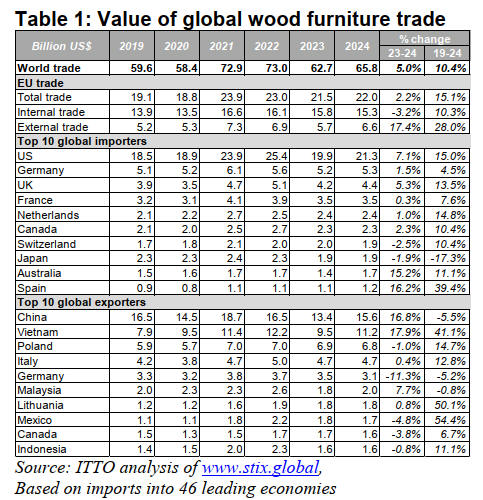
A key feature of the European furniture sector is that it is
characterised by an exceptionally high level of business-
to-business trade concentration and integration. Unlike in
the U.S. where a large share of furniture production has
been relocated to China, Southeast Asia and Mexico, 80%
of current demand in Europe continues to be met by
European manufacturers.
Considering just wood furniture, around 33% (US$ 22.0
billion) of the total value of world trade in 2024 (US$ 65.8
billion) involved EU countries where there is a robust
intra-regional trade network.
Analysis of wood furniture trade data shows that the
sluggish pace of EU internal trade in 2024 had a
dampening effect on global trade. The total value of world
trade in wood furniture increased 5% from US$ 62.7
billion in 2023 to 65.8 billion in 2024. However, if internal
EU trade is excluded, the rise in the total value of global
trade was closer to 8% last year.
The value of wood furniture imports into the EU from
outside the region increased by 17% to US$ 6.64 billion in
2024. Imports of wood furniture products into four other
major global markets also rebounded last year: the U.S.
(+7% to US$ 21.3 billion), the UK (+5% to US$ 4.4
billion), Australia (+15% to US$ 1.7 billion), and Canada
(+2% to US$ 2.3 billion).
These positive trends were partly offset by a 3.2% fall in
the value of the EU internal wood furniture trade to US$
15.3 billion, alongside a 2% fall in Japan’s imports to US$
1.9 billion, and a 3% fall in Swiss imports to US$ 1.9
billion.
China and Viet Nam, and to a lesser extent Malaysia, were
the principal beneficiaries of the overall recovery in global
wood furniture trade in 2024. The value of China’s exports
increased by nearly 17% to US$ 15.6 billion, while
exports from Viet Nam increased by nearly 18% to US$
11.2 billion. Exports from Malaysia increased by nearly
8% to US$ 2.0 billion during the period.
Considering longer term trends, the clear winner in the
global wood furniture trade is Viet Nam for which the
value of exports increased by over 40% between 2019 and
2024. This gain was largely at the expense of China for
which the value of wood furniture exports declined 6%
during the same period.
Nevertheless, last year China was still the world’s leading
exporter of wood furniture by a significant margin.Overall,
the data implies that the widely anticipated trend towards
“reshoring” of production back to historic production
centres such as the US, Europe, and Japan, has yet to gain
any real momentum, at least in the wood furniture
manufacturing sector.
This trend is expected to be driven by the closing gap
between Chinese and US/European production costs, the
reduction of labour intensity due to the progressive advent
of technology, the development of regional value chains,
and increasing demand for product customization and
shorter time to market favouring proximity of
manufacturers to clients.
It should be said though that in Europe the furniture
manufacturing industry never really left. For Europe, the
massive shift to lower-cost manufacturing locations that
characterised the global industry between 2000 and 2020
mainly took place inside the continent – from western to
Eastern Europe - rather than involving any large-scale
move further afield.
Furthermore, the rapidly changing geopolitical
environment this year, particularly the US administration’s
enthusiasm for tariffs to boost domestic manufacturing and
the EU’s imposition of tougher traceability requirements
through EUDR - which create particular challenges for
SMEs and for products based on composite panels and
wood from small plantations or that is imported from third
countries - could yet add impetus to the reshoring trend in
the wood furniture sector in the next few years.
EU imposes anti-dumping duties on Chinese
hardwood plywood
The EU Commission has announced it is imposing
provisional duties of up to 62.4% on hardwood plywood
imports from China, as part of its Anti-Dumping
investigation on hardwood-faced Plywood.
The investigation began following a complaint by the
Greenwood Consortium, which represents the EU’s
hardwood plywood industry. The Consortium’s complaint
alleged that Chinese plywood was being ‘dumped’ onto
the EU market and sold below market value.
While the investigation is ongoing, and due to be
completed within six months, the EU has taken the
following actions entering into force on 11 June, 2025:
Interim levels of additional duty of 62.4% for all
hardwood plywood from China except products
from a single identified Chinese manufacturer for
which a 25.1% rate will apply.
A new requirement for customs authorities in
each EU member state to keep records of
coniferous-faced Chinese Plywood arriving at EU
borders. This action is designed to help prevent
circumvention of the new anti-dumping duties
through modification of the Chinese plywood
products.
Definitive duties are expected to be published in
December.
Full details of the EU anti-dumping measures are available at:
https://eur-lex.europa.eu/legal-
content/EN/TXT/PDF/?uri=OJ:L_202501139
|